Tale of two stones and one ancient kingdom
In a small, insignificant plot at a junction of the Thames stands a large stone with unloved status belying its important role in history.

In a small, insignificant plot outside the Kingston upon Thames guildhall, alongside a junction of the Hogsmill River and the Thames stands a large stone protected by a garish low blue fence.
It looks incongruous sitting before a 1980s grey town administrative block and a local coffee chain – its lowly and seemingly unloved status belying its important role in English history.
For this particular stone, unlike the venerated Stone of Scone which was placed under the ancient chair upon which King Charles was seated inside Westminster Abbey, is the Saxon coronation stone.
Despite being central to the coronations of seven and maybe eight kings more than a millennium ago, this particular stone has been nearly all but forgotten.
It is believed several of the Saxon kings were crowned atop the stone and records show the son of Alfred the Great, Edward the Elder in 900, was crowned nearby although records of King Egbert in 838 show the Saxon kings were deeply associated with the Kingston region, then called Cyningestun, long before that time.
Alfred’s grandson Athelstan was crowned king at Kingston almost 1100 years ago in 925 in a similar fashion and is now considered to be the first king of all Anglo-Saxons after he defeated both the Scots and Vikings to expand his kingdom.
The Saxon coronation stone is made of sarsen – the same composition as Stonehenge – and is believed to have been used to crown Athelstan’s half-brother Eadred in 946, Aethelred the Unready in 979, and historians also believe Edmund I and Eadwig and Eadward the Martyr could have used the stone.
The stone was originally sited at the nearby All Saints church in Kingston for the ceremonies. It was moved to its current location 300m away in 1850. There have been recent moves to relocate the stone back to the 1000-year-old church yard precinct. It has been recorded by church historians that Athelstan first greeted his people in the historic marketplace before entering the church and was the first king to be ordained with a crown placed on his head, rather than a helmet.
All Saints church says more modern coronation traditions began when Athelstan was crowned: “For the first time, the coronation service laid out the responsibilities the king and his people had to each other, and the Christian hymn Te Deum was sung as it is now. The coronation “ordo” compiled for Athelstan was used for subsequent coronations through to the coronation of Queen Elizabeth II in 1953.
A Saxon cross fragment still housed in All Saints formed part of a larger cross that historians believe was involved in the coronations.
It is unknown what object William the Conqueror sat on when he was crowned at Westminster Abbey on Christmas Day in 1066, the first of 40 crownings of kings and queens there. But King Charles III will sit on the oak coronation chair made in 1296 by King Edward I specifically to house the famous Stone of Scone, (also known as the Stone of Destiny), a potent symbol of Scottish nationalism and an object of much mystery.
“King Edward had it mounted beneath the seat of a wooden throne so that to be seated there was, symbolically, to have dominion over Scotland,’’ says the Scone Palace.
However, it’s unclear if this was indeed the same stone that according to legend was used by Jacob as a pillow in Bethel, was eventually taken to the Hill of Tara in Ireland via Egypt and Spain, and found its way to Scotland by Fergus when he moved his royal seat to Dunadd in Argyll in 498.
What is known is that the wooden coronation chair has survived graffiti in the 18th century and a bombing attempt by suffragettes in 1914, and the stone was stolen by four pro-Scottish independence students in 1950 which resulted in the first closure of the border between Scotland and England in 400 years.
The students organised the repair of damage to the stone – it had broken in two when they removed it – and they took it to Arbroath Abbey, the scene of Scottish nationhood asserted by the Declaration of Arbroath in 1320. However, a pub frequented by the students, the Arlington Bar in Glasgow, claims the real stone was deposited there and it has never left, having been stored beneath a boxed pub seat and unearthed during renovations 20 years ago. “We have the Stone. It stays here. There will be no English king coronated on Scotland’s Stone,” the pub tweeted last year.
The Stone of Scone has been transported back from Edinburgh Castle for King Charles’ coronation.








To join the conversation, please log in. Don't have an account? Register
Join the conversation, you are commenting as Logout